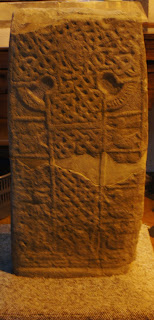
about a mile from the Monmouthshire border town of Chepstow. It seems to have been attached to the old monastery of St Kynemark , about which I posted in Mary in Monmouthshire dot blogspot dot com, the sister blog to this. In the fourteenth century procurations added to the Book of Llandaff is is called Ecclesia de Sancto Aryuno or Arvino .In 1254 it ccertainly belonged to the monestary at St Kynemarks and like Trellech Grange and Penterry became part of the Hamlet.
 However St Arfan seems to have been a hermit or even the resident priest at the small chapel here. The name has been spelt in many different ways and traditionally Arvan (or Ervan, Arvin and Arveyn) is known to have been resident at the settlement. Traditionally he was of the ninth century and he is said to have supported himself by fish he caught in the Wye. He, like so many Welsh used a coracle to fish but died but was drowned when his coracle sank and the church's website says there was for many years a stone carving showing a coracle and a salmon. This early structure was possibly a wooden or mud and wattles affair, yielding to perhaps a small stone building, but most of the original building still existing was late Norman.
However St Arfan seems to have been a hermit or even the resident priest at the small chapel here. The name has been spelt in many different ways and traditionally Arvan (or Ervan, Arvin and Arveyn) is known to have been resident at the settlement. Traditionally he was of the ninth century and he is said to have supported himself by fish he caught in the Wye. He, like so many Welsh used a coracle to fish but died but was drowned when his coracle sank and the church's website says there was for many years a stone carving showing a coracle and a salmon. This early structure was possibly a wooden or mud and wattles affair, yielding to perhaps a small stone building, but most of the original building still existing was late Norman. In the fourteenth century procurations of the Book of Llandaff (Liber Landavensis) it is called Ecclesia di Sancto Aruyno (p 322) By 955, however, it seems to be that spoken of as Ecclesia Sanctorum Jarmen et Febrec (p219) A deacon had fled here for sanctuary when he had basely murdered a man who was binding up his wounded thumb! The circumstances say Baring Gould and Fisher , were these.The deacon ,Ili accosted a reaper called Merchitir in a field , and they had an argument, when the reaper struck at the deacon with his hook and sliced off one of his fingers. the deacon begged the man to bind up the wound and whilst the latter was doing this, he stabbed him to the heart with a knife and then ran to the church for refuge. The relatives of the murdered man of Nowi(Nogui) broke into the church and killed the deacon before the altar! Bishop Pater was furious. He summmoned a council and threatened the king with excommunication, unless the culprits were delivered up

(Sinodo judicante diffinitum est ut unusquisque eorum suum agrum,suam que substantiam insuper et pretium animae suae hoc septem libras argenti redderet ecclesiae quam maculaverat)
All the men lived near the church, which benefited from the fines and there is no doubt at this time in 955 it was called the Church of SS Jarman and Febric as the Book of Llandaff confirms it in the document relating to the grant of Llan Beduei (otherside known as 'Penterry') to the Church of Llandaff. Sir John Rhys (Archeologica Cambrensis 1895 p.38 in an article of goidels in Wales) regards Febric (aka Jarmon) as the Goedelic form of a name which occurs in the St Teilo Gospel (otherwise known as the Book of Chad(!!) as GUHEBRIC and in the Book of Llandaff as Guebric and Huefric.
The local King Nogui gave up the men and the Bishop confined them to prison at Llandaff, fast chained for six months and then only released them after they paid a heavy fine in money and surrendered all their possessions to the churchHence he is linked to St Guernabui , who was a disciple of St Dyfrig/ Dubricius. He was appointed princeps or head of a mmonastic settlement in Garth Benni. This place is identified as Welsh Bicknor. Pepiau son of Erb, king of Ergyng (west Gwen) granted Mainaur Garth Benni 'usque ad paludum nigrum inter silvam et campum et aquam et jaculum Constantini regis socri sui, trans Guy amnem ' to God and Dubricius and delivered it into the hands of Junapaelus'. It is possible that the term jaculum Constantini regis socris sui
could refer to a menhir or burial stone of the former king used as a marker.
Guwernabui is mentioned as having had a pupil called Gurguare , a disciple meant to succeed him at Garth Benni . He seems to have been associated with Aidan the bishop at the granting of Mafurn by Cinuin son of Pepiau and at the grant by Arthryws, King of Gwent to Bishop Comeregius and a regrant after devastation of Llan Cynfarch (Lann Cinmarch) Llandewi , Llan Junabui and other churches. Gurguare appears as an abbot of Llan Ennniaun or Llandogo (dedicated to St Euddogwy) which is not far away from St Arfans.It seems, therefore to have had a fair share of holy founders.
I must say I found this quite a hard judgement, considering the original murder was by the deacon, but still neither man was able to tell the tale.
Nathaniel Wells of Piercefield Park paid for the distinctive octagonal tower which can be seen here and was built in 1820.














No comments:
Post a Comment